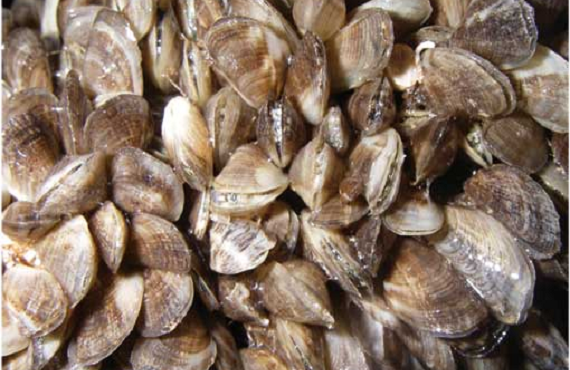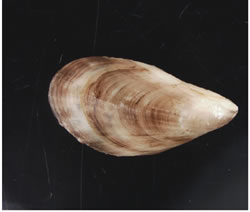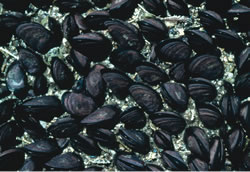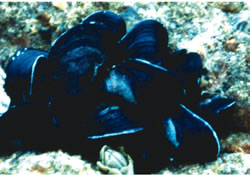Black-striped mussel
Black-striped mussel (Mytilopsis sallei) are a small marine bivalve mollusc originating from Central and South America. They have spread to several countries in the Indo-Pacific region and are considered a serious pest because of their ability to rapidly establish huge populations and cause significant environmental and economic impacts.
There are no existing populations of black-striped mussels in NSW waters. However, in 1999 they were discovered in several enclosed marinas in Darwin Harbour and successfully eradicated.
Black-striped mussels may easily be introduced into Australian waters by vessels travelling from infected ports in other parts of the world. They tolerate a wide range of temperatures and salinities and have the potential to colonise much of the Australian coastline, including the NSW coastline down to and around Sydney. They can attach to any solid surface and are extremely prolific breeders.
If they became established in NSW waters, these mussels could devastate the shellfish, fishing, tourism and other marine industries. In suitable habitats they can establish dense beds (up to 10-15 cm thick), leading to massive fouling of all kinds of marine structures including hulls, chains, ropes, nets, wharves, marinas, mooring buoys, piles, floating pontoons and so on.
Black-striped mussels are also able to settle on hard shell surfaces of other marine animals such as oysters and other mussels, causing major problems for shellfish growers. Dense mats of mussels have the effect of excluding most other species, leading to a substantial reduction in native biodiversity.
The Black-striped mussel is listed as prohibited matter under the NSW Biosecurity Act 2015 and is considered a major threat to native fauna and the environment. It may not be brought into NSW or released or allowed to escape into any waters in NSW.
Reporting
If you think you have seen a Black-striped mussel in NSW, please take several clear, high resolution photos of the mussel. For identification, we need to see the:
- Shell colour and markings
- Mussel size – please include something for reference (e.g. a coin)
- Shell overbite (where larger shell meets smaller shell)
Please send photos to aquatic.biosecurity@dpi.nsw.gov.au, along with details of when and where the mussel was seen. Please note if the mussel was found as a clump of individuals.
Identification

Key features
- Smooth fragile shell (crushes easily)
- One side of shell overlaps the other
- Varied shell colour from black/brown-light grey/white
- Some show light and dark zig zag pattern or longitudinal stripes
- Small (fingernail sized) up to 2.8cm in length
- Forms dense clusters, rarely seen as individuals
Known locations
- Not established in Australia
- Previous incursion in Darwin, NT successfully eradicated

Habitat
- Hard structures
- Sheltered inshore estuarine to marine
- Subtropical to tropical waters
Vectors
- Biofouling on vessels
Impacts
- Rapidly establishes huge populations
- Competes with natives for food and space
- Affects productivity of commercial fisheries and aquaculture
Similar native species
These native species may be confused with the Asian date or bag mussel. These species do not need to be reported.
Brachidontes rostratus
 Key features
Key features
- Log flat shell up to 4cm
- Purple colour, regular rounded ribs
- Usually found in dense clumps
Habitat
- Exposed rock platforms
Little black horse mussel (Xenostrobus pulex)
Key features

- Small shiny inflated shell up to 2.5cm in length
- Black colour
- Forms dense clumps
Habitat
- Exposed rocky shores
- Mid intertidal